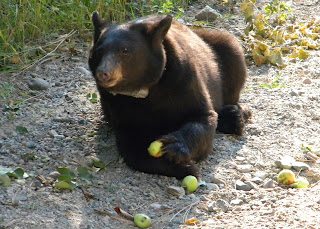 |
| Panoramic view of Missoula's Rattlesnake Valley - click on any image to view a larger version. |
From January 2008-December 2010, I worked on a Master's degree at the University of Montana. My project was both intriguing and challenging. In collaboration with local wildlife managers, residents, and community groups, I was trying to come up with some data that would provide insight into the habits of black bears that are increasingly present in Missoula.
 |
| Big male black bear in a yard in the Lower Rattlesnake (B.G. Merkle) |
My research process was full of ups and downs, and included capturing and collaring black bears, hiking through the surrounding woods hunting for bear dens and monitoring berries, and even juicing apples and counting garbage cans in the dark on garbage nights.
 |
| Apples from tree #7; monitored weekly for two seasons |
The results were well worth it, and we have had most of them published. One of the key findings was that humans aren't the only mammal with a taste for sweet, juicy, locally grown apples. It appears Missoula-area black bears have figured out when and where backyard apple trees ripen, and they don't seem quite as enthralled by garbage.
 |
| Credit: Dan Laparko, Missoula, MT |
Just recently, one of my favorite articles on this project was published in Fair Chase. It is a plain-language article I wrote (with contributions from Bethann and my master's advisor, Dr. Paul Krausman) which covers highlights from the whole project.
Here's a snippet or two from that article:
 |
| Bear scat (B.G. Merkle) |
Fair Chase, Fall 2012 (pgs. 73-77)
"A landowner told me the best way to know when apples are ripe is when you start seeing little 'presents' under the trees. As he told me this, we stood staring at a rather large black bear scat that had been deposited from high up in the apple tree above us. [...] Little did I know at the time, but this conversation would be central to my master's work on reducing human-bear conflicts within urban areas."
"Conflicts are a reality in most societies that co-exist with wildlife. In scientific terms, human-wildlife conflicts are interactions between humans and wildlife species that lead to a negative impact on either the animal or the human. [...] Reducing these conflicts is a good idea for both humans and bears, but how do we do it and where to we start?"
"The initial objective [of my Master's study] was to describe the movements and diet of black bears living in Missoula. I quickly figured out where bears were going (into town), and what they were eating (food sources provided by human residents). I had to think more deeply about how to develop a research project that could actually assess and inform proactive management strategies and reduce the probability of human-bear conflicts."
Read the full article . . . -->
.jpg)
4 comments:
Oh, I loved reading this one!!! Fun! Nice job! What is the readership of Fair Chase? Is it a MT magazine or broader publication than that? Can I buy one issue to get a printed copy?
Hey, Bethann,I tried printing the html but it's all messed up. Also could't download the file from Scribd 'cos it ain't public. wah!
Any chance you could email me the pdf or send a link to something that prints sensibly?
Cheers,Pat
Hello Pat!
We changed the setting on the Scribd file, so it should work to download it now. Thanks for pointing out that glitch!
Thank you!
I don't know what the readership is, but it is national, at a minimum. The magazine is distributed to all B & C members (regular, professional, and associate), so that's probably a fair number of folks. Whether it is international, I don't know.As for your question of getting a printed copy, I'm not quite sure how it works with Fair Chase. I know you can purchase back issues, but this article just came out in the Fall 2012 issue, which is the current issue. We'll look into it, and let you know.
Post a Comment